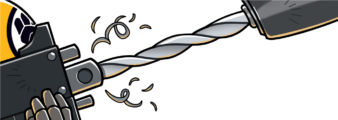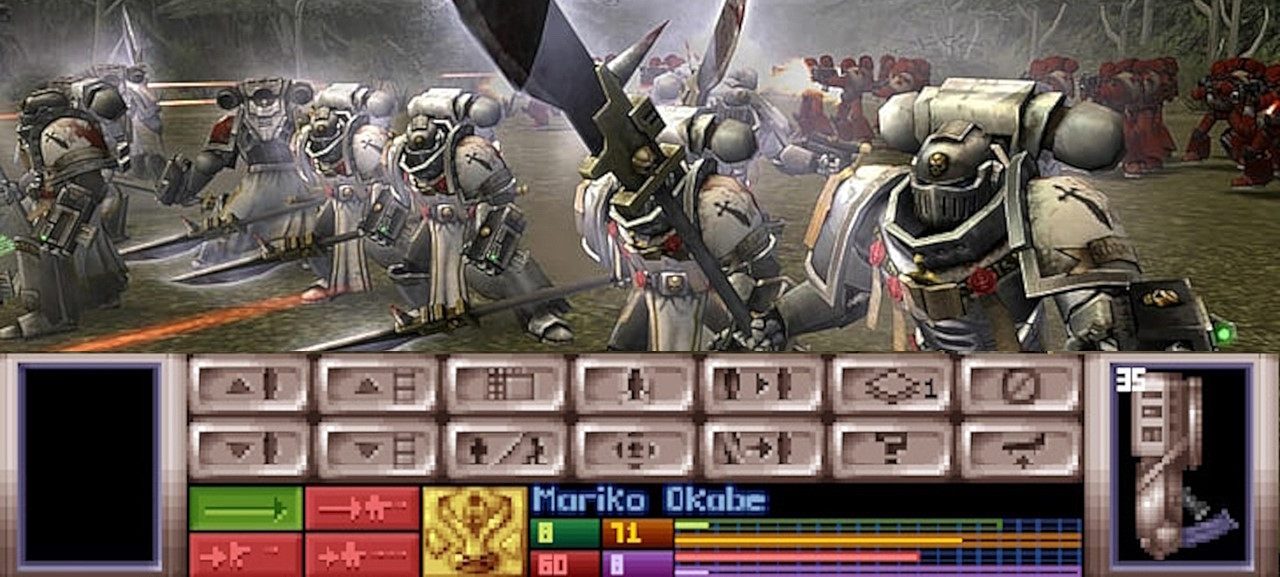“Space Marine XCOM” hasn’t been a seriously developed video game concept since 1998. That was when the sergeant of the squad was first encouraged to accept his orders in Warhammer 40,000: Chaos Gate. But eventually the concept was revived – and the Grey Knights are at the fore-front. That’s right, I’m reviewing Warhammer 40,000: Chaos Gate – Daemonhunters. You can all thank my podcast co-host who gifted it and my feverish approach to playing any decent game until I burn out.
The Baleful Edict is a Grey Knights strike cruiser that’s returning to Titan to recuperate the damage it and its crew have sustained hunting a Khornate cult. However, the ship gets waylaid by Inquisitor Valkir. She’s hunting “The Bloom”, a sinister new plague cooked up by the servants of Nurgle. As the newly promoted Commander Never Takes To The Fight Personally, you’ll have to juggle the capabilities of your Knights and ship as well as the strong personalities involved in the fight to meet everything that the Bloom throws at you.
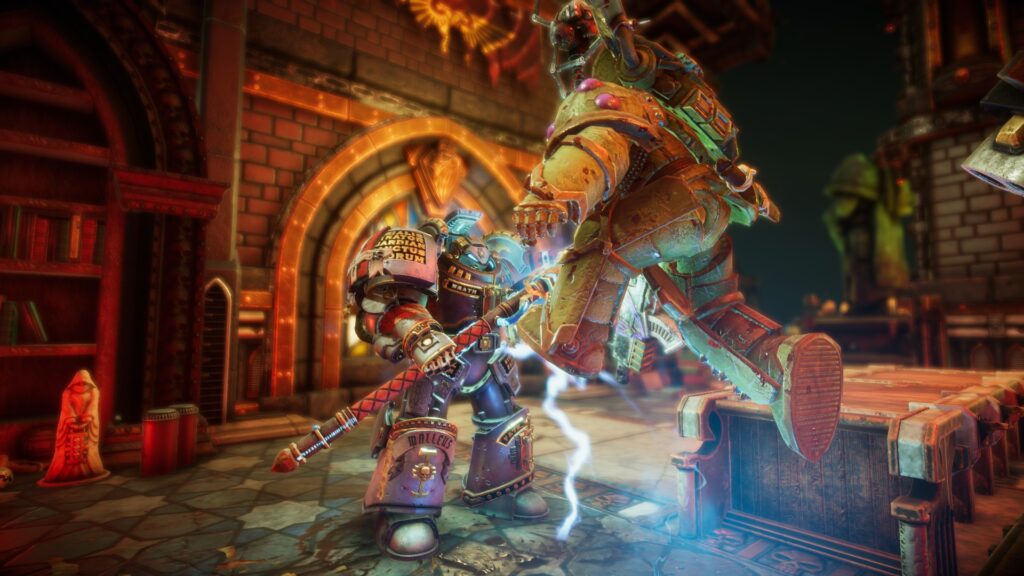
Tactics of the Non-Tactical Marines
At the very basic level, Warhammer 40,000: Chaos Gate – Daemonhunters is a neo-XCOM game. You have up to four troops on the field and their abilities and armaments are narrowly defined by their class. Meanwhile, the battlefields are destructible – with crates of loose plasma cells just waiting to explode – and provide either half or full cover. The enemies, on their end, hang out in pods in the fog of war. Once revealed, they scatter like roaches.
But the developers ain’t dumb and there are some tweaks to the system to reflect that you’re fielding psychic superhuman sons on the Emperor clad in spiritually-warded power armor. Hit chances are out – Space Marines don’t miss – with cover mitigating or entirely canceling out damage instead. You also get three action points to play with – including attacking thrice if the spirit moves you.
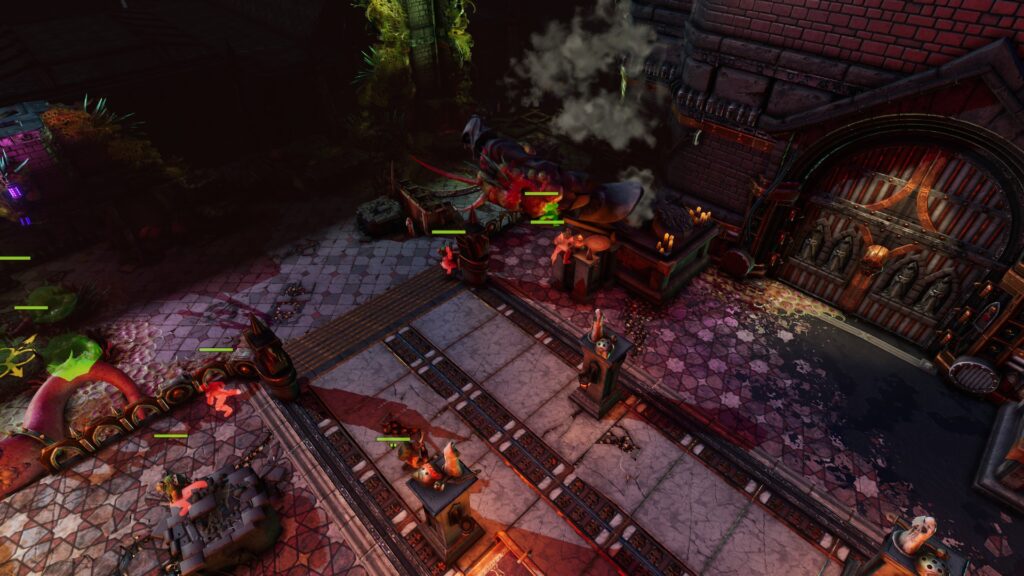
Your spirit can also move others as the Grey Knights are all psykers. The simplest power, available to all characters, is Aegis, giving temporary armor (read: HP) for a turn. It doesn’t even cost Willpower points! WP are the ammunition of the brain, and they’re going to be essential as they fuel everything from boosting your attack damage output to obvious psychic powers like teleportation strikes and mind storms. And it is by slaying heretics and demons that you refill your Willpower pool.
However, there are ways to prevent you from just running the psychic train on hapless heretics and traitors. You shoot mind bullets by leaching power from the demonic realms and thus all WP spend counts towards the Warp Surge Meter. It’s a system that throws curveballs at you to encourage ending the mission swiftly. Surges can disable healing, make psi powers hurt the user, boost enemy attacks and even spawn hostile reinforcements. You can’t avoid the surges by XCOM-camping on overwatch: the meter rises anyways, but magically cleaving a Plague Marine’s ass off makes it rise faster.
I don’t care what the RAI is
But killing is more than about depleting health bars: each enemy has a stun counter and it ticks down every time the foe is attacked. Once the enemy is stunned, it can be critted automatically: most can then be executed, which as a bonus also restore a single AP for each member of the team. Play your Knights right and you can thus sweep-advance entire swathes of enemies in a turn.
Crits are important outside of executions, however. They bring a little Phoenix Point to Daemonhunters: crits also give you precision attacks that allow you to destroy parts of the enemy for various effects. The mundane use is cleaving melta guns and plague spewers off Plague Marines. But precision attacks are straight up vital in crippling boss enemies – their abilities are both more numerous and increasingly lethal.
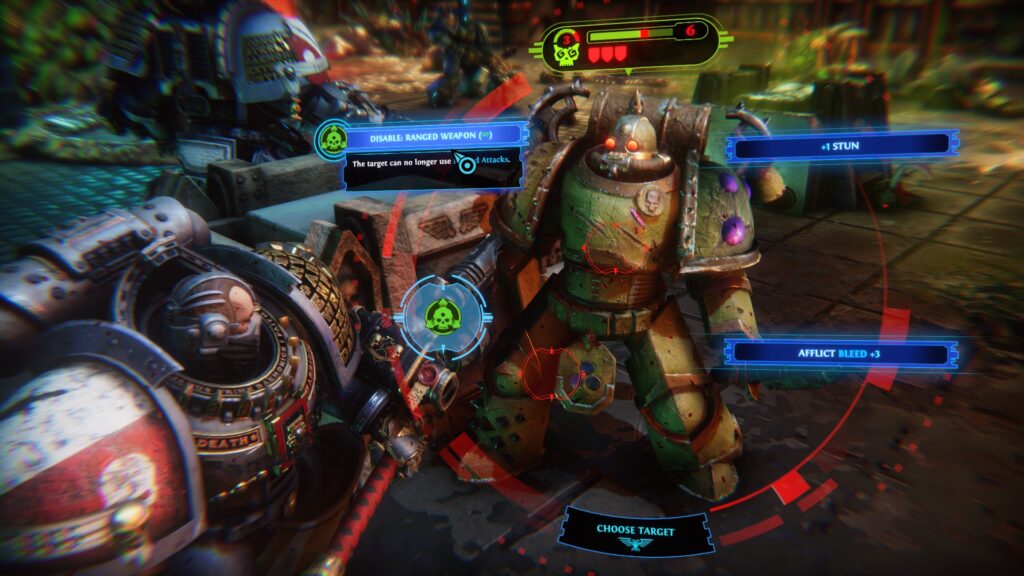
There’s also some fuckery involved in the missions – and I’m not talking about throwing enemies off the ever present cliffs to score easy kills. Bear with me here: while the Knights move in turn-based mode even outside the fight, discovering a pod of enemies immediately refills their AP allowance. Killing the last enemy in an encounter also fills your AP up. This is very important for mission timers or timed buffs – if the turn hasn’t ended yet because you gave yourself 6 more AP, then the turn counter doesn’t advance, what are you talking about?
A less gamey part of Warhammer 40,000: Chaos Gate – Daemonhunters is taking Apothecaries (Space Marine healers) in every mission. Since armor suits just increase your Knight’s HP pool and Armor as a mechanic is just temporary HP, you’ll be losing HP with every enemy attack. This makes Apothecaries and their unlimited (outside of WP costs) healing basically irreplaceable in any mission.
After a thousand battles one only sees reused assets
Luckily, Space Marines are tough, so any Knight that goes down in battle will self-revive in three turns with halved health. If they survive the mission, they’ll be critically wounded and unavailable for deployment for some time (less mangled Knights can deploy with a health penalty). Luckily the developers of the game are smarter than Necromunda developers and fairly soon you’ll have a ship upgrade that will critically graft critically injured Knights with bionic parts that grant small bonuses.
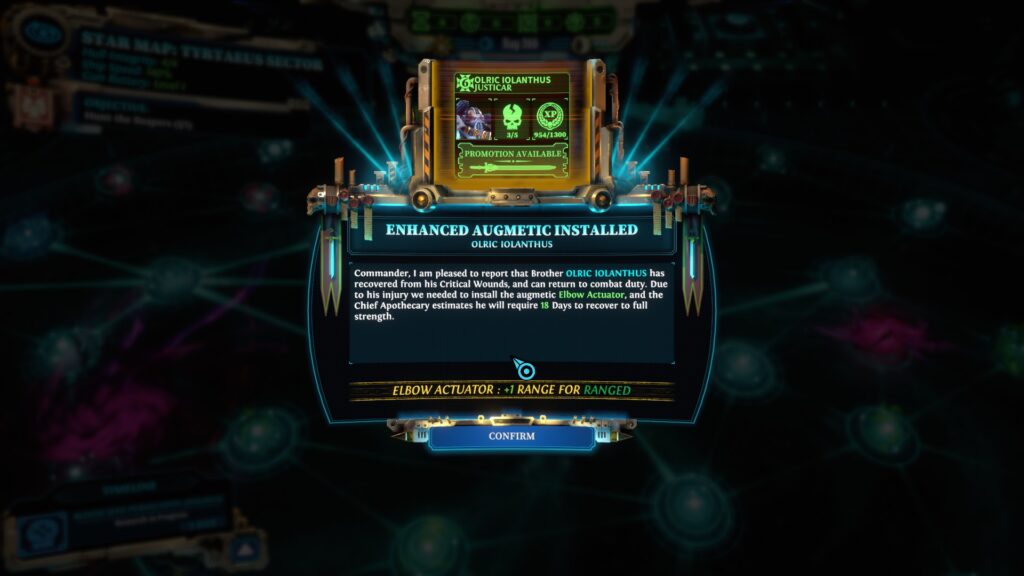
Unfortunately, I have to talk about the biggest flaw of Daemonhunters: mission variety. Most of the time you’ll be tasked with destroying (up to) three specific generic enemies or (up to three) Bloom structures or defending three servitors (with disposable Guardsman escorts). Even if the game tries to spice it up with different worlds having slightly different biomes (or, rather, maps), you’ll always be fighting some combo of Plague Marines, Dark Vengeance cultists and Nurgle daemons.
Even the map layouts will become familiar and boring, with only the randomly generated pod contents spicing it up.
But once you have wiped the floor with one Chaos Armiger…
Battlezone: Sector That Was Never Named Before
Transitioning to the campaign side, the non-plot missions appear at certain intervals. You have to manage time as you fly from one planet to the next – this is triage, because even a fully upgraded repaired Edict won’t be able to hit all of them. Missions that time out increase the planetary Bloom infection level, which can lead to outbreaks spreading to nearby planets – or worse.
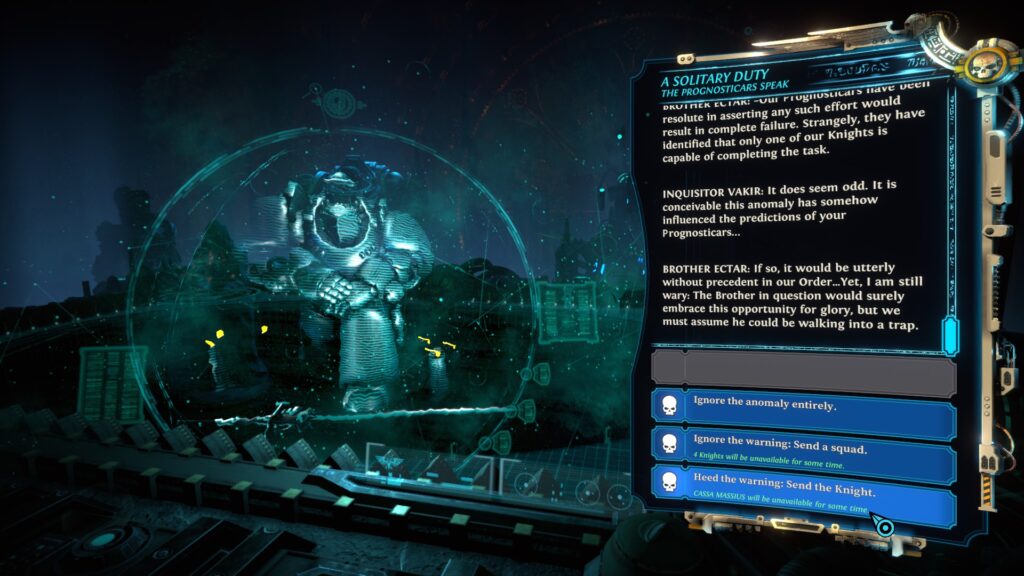
Time is also what you need to spend for injured Knights to heal, construction to take place and to research stratagems (read: one use boosts for tactical missions). As you fly around, you’ll be hit with random events, encounter Death Guard cruisers and be imperiled by warp storms. I was pleasantly surprised by the amount and variety of random events, which really spice up the otherwise humdrum task of watching the Edict fly around. I wish some of the random events were longer than a single choice, but the rewards can already be fairly nice. Sending out one of my Knights to return as an elite Paladin months later was fun. And missing your all-stars for a couple of months gives you additional impetus to level up the others.
Each class of Knight has a different spread of skills, and many Knights come with a random starting trait (including one that boosts the Knight early on for the price of not being able to reset their career-ending critical wound counter). And while there’s an obvious path – Interceptors are naturally well-suited to ganking backline targets with Hammerhand – the trees actually hide subtle sub-classes. For example, Cassa Massius, an Interceptor I named after my pod’s other host, unlocked the psylencer and became a very mobile heavy-support choice.
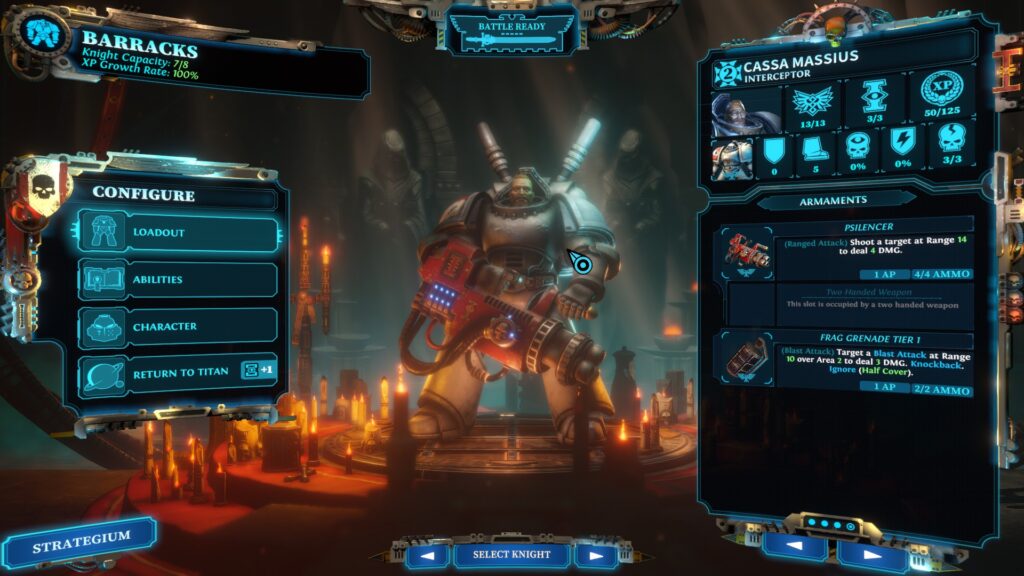
A Knight is heavily reliant on his tools, yes, but as this is 40K, you’re not manufacturing it. No, instead, you gain Requisition points via various means (but mostly mission objectives and challenges) which you spend after missions. As your reward, you’re given five items – one of each from ranged and melee weapons, armor, utility and new Knight recruit – and you can take some, all, or none based on whether you have the Requisition to spend. You know roughly what the rewards will be – a level 1 storm bolter, a level 2 Terminator armor suit, etc. – even beforehand. Sometimes, this impacted my choice of missions more than Bloom levels or regular rewards.
Each item class has their own peculiarities – halberds give you a chance to attack the first enemy that comes close while falchions have a higher crit rate – but that doesn’t mean that a level 1 storm bolter is equal to another level 1 storm bolter. There can be variations in attack strength, range, stun power, increased damage against demons and so on. And while it’s not necessary to go for peak optimization, sometimes, the known enemy composition will suggest whether you want to go with, say, the increased range psilencer or the one that ignores Armor.
The big difference between power armor and Terminator suits is that the former grants much more vertical maneuverability while the latter has Armor by default. Weapons and armor can, later in the game, be upgraded which reinforces their inbuilt weirdness, like a storm bolter with a stun bonus getting even better at stunning.
These are my battle brothers: Genericus and Nondescriptus
Now, the greatest issue with the campaign play is that your Knight force is faceless. Oh, you can customize how their armor looks and the voices they have, but they’re not characters that live and react to the world. At best, they can be harmed or improved via random events, but they have no reaction to the world, other characters or their own brothers. The only two Knights I remember are my first Justicar Iolanthus, who got the most sinister voice of my group and would hiss out his own name when selected, and Cassa Massius.
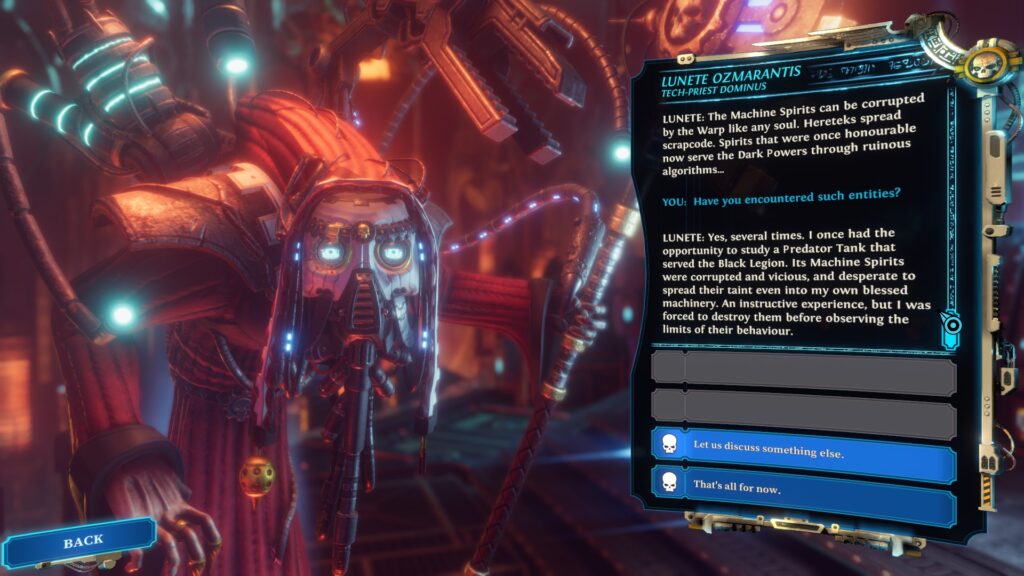
I guess this is an issue because playing the Lamplighters League has convinced me that bespoke characters a la Jagged Alliance 2 beat the churn of faceless goons anytime. Nothing beats interpersonal banter and dialogue hinting at their backgrounds.. And when you’re dealing with the most special of already plenty-special Space Marines, you could get up to some ridiculous shit. Maybe even make reference to the “killing Sisters of Battle for their incorruptible blood” nonsense being a stupid myth.
Of course, that would require more time and money to be spent on creating such heroes, and I’m sure Aaron Demski-Bowden is a busy man. Having him aboard must have help immensely with the writing in the game, as it definitely has its moments. Brother Ectar, Inquisitor Vakir and Techpriest Dominus Lunete are some strong personalities and they carry the plot forward, even if they’re not as memorable as the cast of Mechanicus.
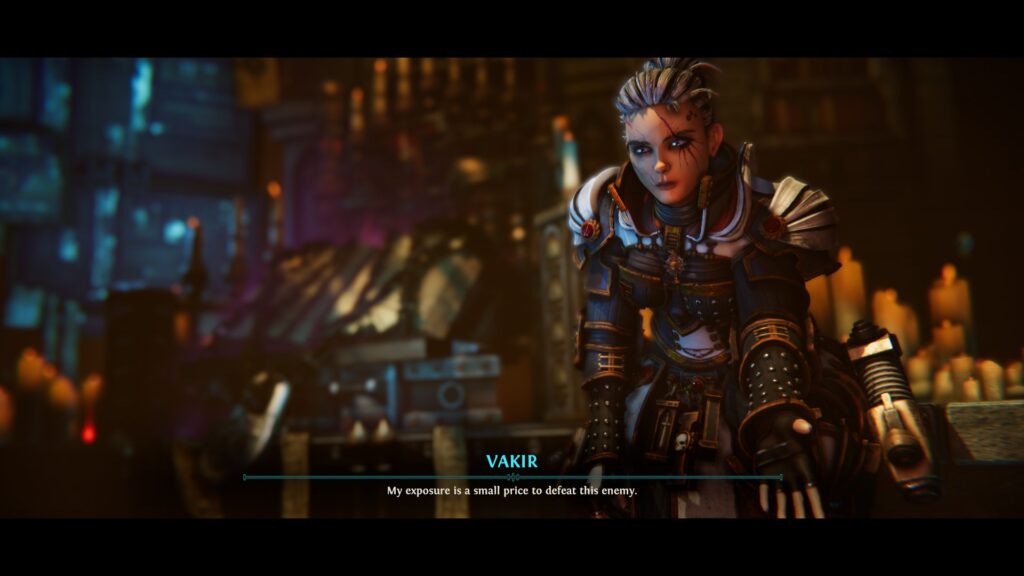
The art, however, is. Warhammer 40,000: Chaos Gate – Daemonhunters makes the bold choice to go with an exaggerated cartoony look, which, in the end, works. The Inquisitor being waifish thin may feel a little silly, but this sort of style lends itself well to the expressive, maybe even unsubtle animations in the (in-engine) cutscenes. I wonder how much of this was a conscious choice based on resource allocation – if the moves and facial expressions of your characters are more bold than they are fluid, then the cartoony stylization helps them look a lot less out of place.
Now, what doesn’t work is the game itself. Warhammer 40,000: Chaos Gate – Daemonhunters is the most crash-prone game that I’ve played in a long time. It started with an amazing crash that corrupted my save file – luckily, I was fresh out of the tutorial, so I didn’t have to replay that much. Then there was the quiet terror I felt whenever the screen went black in anticipation of a cutscene. Those crashes were never that catastrophic, partially because the game auto-saved fairly often. But I also had a couple of scares even mid-mission as the game would hang up the end of somebody’s turn. I’ve also had some bugged-out sound effects – localized to a certain section of the map, so not really an issue once I moved away, but also persisting between missions. Bonkers!
Game goodish
In the end, Warhammer 40,000: Chaos Gate – Daemonhunters is what a Google search says it is: a 7/10 game. All the creative choices made into making Space Marines work on screen are dragged down by the sheer lack of mission variety. Given more map variation and more interesting goals, I could forgive the crashes or your Knights being flavorless goons. Having fewer mission types than main characters hurts about as much as the fourteen-year-old sculpts hurt the tabletop army.
